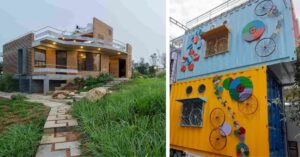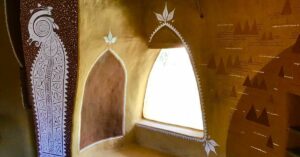Why a Pune Couple Is Using India’s Traditional Construction Methods to Built Cement-Free Homes
Dhruvang Hingmire and Priyanka Gunjikar, architects of 'Building in Mud', create cement-free, eco-friendly homes that stay cool, using natural materials and lime plaster.

Dhruvang Hingmire and Priyanka Gunjikar aren’t your conventional architects. Besides building homes with their own hands, the Pune-based couple practise a form of architecture that uses natural materials, and employs local labour and construction.
The name of their architecture firm ‘Building in Mud’ conveys exactly what this couple creates when building your home. They use all-natural materials, which are locally available at the construction site of their project.
Forgoing cement completely, they use lime plaster as a binding agent, which ensures that the houses remain sturdy and cool even in the hottest of weather. Using cement obstructs any breathing that happens through the walls of your building, which is why it heats up so much.
“We have to find a balance between ecological viability and the client’s wishes. For a project near Bhor, the client wanted a rustic look to the house. So, we didn’t go for interior plastering. But, in a project at Kamshet, they wanted a low-maintenance house. So, we went for lime plasters unlike cement, which is bad for the environment. Moreover, lime is completely recyclable and possesses a greater thermal insulation value,” informs Dhruvang.
Born and raised in Pune, Dhruvang attended Rachna Sansad Academy of Architecture in Mumbai, where he met Priyanka. In college, they were influenced by a senior architect, Malaksingh Gill, a proponent of eco-friendly, culture-sensitive architecture and student of the famous Lawrence Wilfred “Laurie” Baker, a British-born Indian architect.
So how did these two young architects choose the unbeaten path?
Well, Dhruvang attributes this to a college trip to Satara in Maharashtra where they came across an old woman living by herself in a dilapidated house. Seeing that they could barely help her as students, Dhruvang decided that he would not move into conventional architecture but work towards building homes.
Whenever Priyanka and Dhruvang get a project, they conduct a preliminary recce of the location and its surrounding areas. They study the houses, materials, where these can be procured, and the technology used. If you found our stories insightful, informative, or even just enjoyable, we invite you to consider making a voluntary payment to support the work we do at The Better India. Your contribution helps us continue producing quality content that educates, inspires, and drives positive change. Choose one of the payment options below for your contribution- By paying for the stories you value, you directly contribute to sustaining our efforts focused on making a difference in the world. Together, let’s ensure that impactful stories continue to be told and shared, enriching lives and communities alike. Thank you for your support. Here are some frequently asked questions you might find helpful to know why you are contributing?

Essentially, it takes about four months to complete the core structure, and another four to five months to finish the interiors.
To find out more about the firm and the architects, watch this video:
Edited by Pranita Bhat
This story made me
-
97
-
121
-
89
-
167















